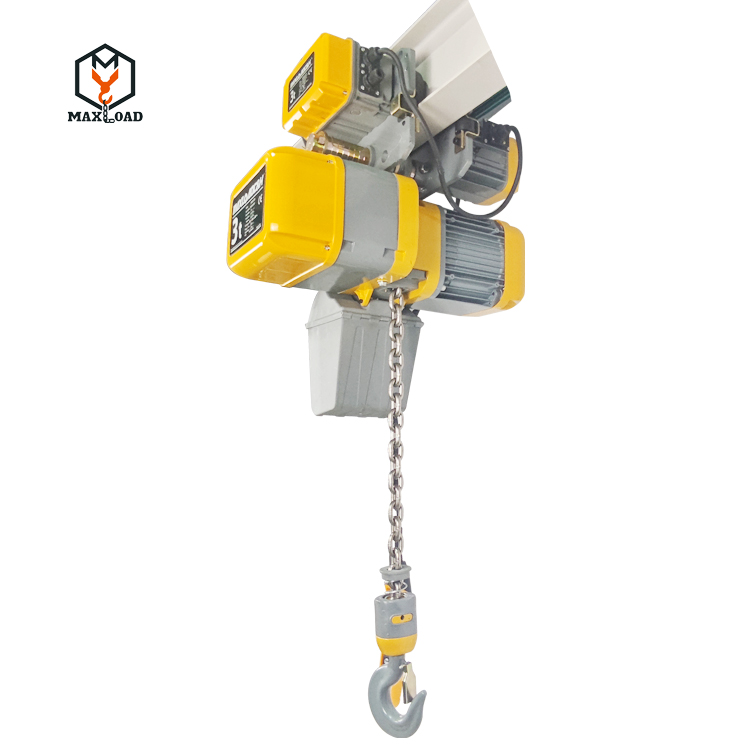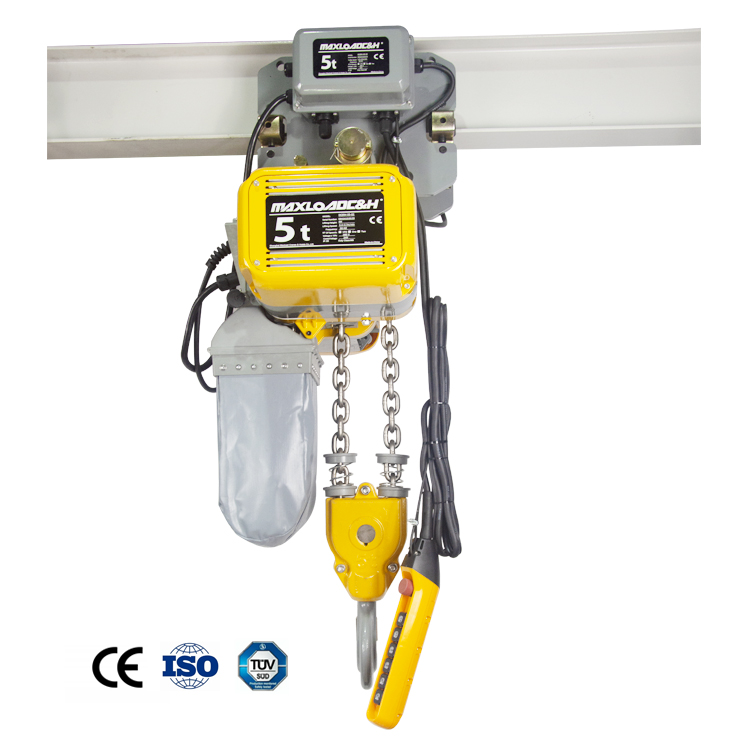Braking Principle of an Electric Chain Hoist
As a crucial component of industrial lifting equipment, the reliability of the electric chain hoist's braking system is directly related to operational safety and efficiency. This article will begin with the basic structure and systematically explain the physical mechanism, control logic, and safety features of its braking principle, aiming to reveal the scientific essence of this core technology without disclosing specific brands.
I. Basic Structural Framework of an Electric Chain Hoist
An electric chain hoist consists primarily of five major components: a motor, a reduction mechanism, a chain drive system, a braking device, and an electrical control system. The braking device, a core safety module, is typically integrated into the motor shaft or the output shaft of the reduction gear. It reliably stops the load through mechanical friction, electromagnetic suction, or hydraulic resistance. Its design follows the principle of "brake on power failure," ensuring automatic braking at the moment of power loss to prevent the load from sliding due to inertia or gravity.
II. Physical Mechanism of the Braking System
Mechanical Friction Braking Principle
A typical design utilizes a spring- and friction-plate combination. When the motor is energized, the suction generated by the electromagnetic coil overcomes the spring pressure, disengaging the friction plate from the brake wheel and allowing the transmission system to rotate freely. When power is removed, the electromagnetic attraction disappears, and the preloaded spring pushes the friction pad against the brake wheel surface, generating braking torque through surface-contact friction. This design offers the advantages of a fast response, adjustable braking force, and eliminates the need for a continuous external energy source. Friction materials are typically made from high-temperature-resistant, low-wear composite materials to ensure stable performance over long-term use.
Dynamic Control of Electromagnetic Brakes
Electromagnetic brakes directly control the braking state via electrical signals. Their operating logic can be described as follows: When power is applied, the electromagnet generates a magnetic field that attracts the armature, causing the brake arm to open and release the brake wheel. When power is removed, the magnetic field disappears, and the preloaded spring pushes the brake arm back into position, achieving a clamping brake. The advantage of this system is that braking and releasing are completely controlled by electrical signals, allowing for precise speed regulation and soft braking via linkage with a PLC or frequency converter. Some designs utilize dual electromagnets, controlling braking and release separately, enhancing system redundancy.

Special Applications of Hydraulic Braking Systems
In large electric chain hoists, hydraulic braking systems use oil pressure to push pistons, driving the brake shoes to press against the brake discs. Its characteristics include high braking torque and excellent thermal stability, making it suitable for high-frequency, heavy-load operating conditions. The hydraulic circuit is typically equipped with pressure sensors and accumulators to ensure at least one complete braking action in the event of a power failure, meeting the "fail-safe" requirements of safety regulations.
III. Energy Conversion and Thermal Management During Braking
During braking, the load's kinetic and potential energy is converted into heat through friction. For example, when lowering a fully loaded 1-ton electric chain hoist, the braking system must reduce the kinetic energy from approximately 500 J to zero within 0.5 seconds while absorbing the heat generated by the potential energy change. The design must consider the heat resistance of the friction pair, typically using forced air cooling or heat sinks to increase thermal capacity. In high-temperature environments, some high-end models incorporate thermistors or temperature sensors. When the temperature exceeds a threshold, an alarm is triggered or the duty cycle is limited to prevent brake failure due to thermal decay.
IV. Safety Control Logic and Redundancy
Dual Braking System Configuration
According to international standards such as EN 14492-2, electric chain hoists must be equipped with both a primary brake and an auxiliary brake. The main brake provides regular braking, while the auxiliary brake intervenes if the main brake fails, providing dual protection. For example, the main brake utilizes electromagnetic friction, while the auxiliary brake may utilize a hydraulic caliper or mechanical pawl. This ensures that no single failure point will cause total failure.
Power-off Protection and Manual Release
The braking system must be designed to ensure "brake on power failure" and equipped with a manual release mechanism. During maintenance or emergencies, the operator can release the brakes using a manual rocker or rotary handle, and to be lowered slowly. The manual release mechanism is typically linked to a gearbox to ensure a controlled release process and prevent a sudden fall.
Overwind Protection and Limit Switches
The braking system is linked to upper and lower limit switches. When the hook reaches its limit position, the electrical system automatically disconnects power to the motor and triggers the brakes to prevent top or bottoming out. Some designs utilize encoders or proximity switches for precise position feedback, combined with a PLC for closed-loop control, improving positioning accuracy and safety.

V. Maintenance and Performance Optimization
The long-term reliability of the braking system depends on regular maintenance. Key maintenance points include inspecting friction pad wear, adjusting spring preload, testing electromagnetic coil insulation, and monitoring hydraulic oil cleanliness. For example, friction pads should be replaced when their thickness is less than 50% of their original thickness. Spring preload should be regularly calibrated with a torque wrench to ensure braking torque meets the designed value. Furthermore, brake cleanliness directly impacts heat dissipation efficiency, requiring regular removal of dust and oil to prevent degradation of braking performance.
In terms of performance optimization, modern electric chain hoists are moving towards intelligence. Some models integrate brake temperature monitoring modules, which upload real-time data to the cloud via the Internet of Things (IoT) for predictive maintenance. Others combine brushless motors with electronic brakes, achieving smooth braking through vector control, reducing mechanical shock and extending equipment life.
VI. The Engineering Significance and Future Trends of Braking Principles
The braking principle of electric chain hoists not only impacts equipment safety but also epitomizes technological innovation in the industrial lifting field. From early purely mechanical braking to today's integrated electromechanical and hydraulic control, the development of braking systems has consistently centered around the three core principles of safety, efficiency, and intelligence. In the future, with the application of silicon carbide power devices, high-precision sensors, and AI algorithms, braking systems will achieve faster response times, more precise torque control, and more intelligent fault diagnosis, driving industrial lifting equipment towards higher reliability and lower energy consumption.
In summary, the braking principle of an electric chain hoist is the result of a multidisciplinary convergence of mechanical engineering, materials science, and electronic control. Its design must comprehensively consider braking torque, thermal management, safety redundancy, and ease of maintenance to ensure reliable safety under various operating conditions. With technological advancements, braking systems will continue to evolve, providing solid support for safe and efficient industrial production.



 0086 17717607077
0086 17717607077
 0086 (021) 5999 9072
0086 (021) 5999 9072
 market@chnhoist.com
market@chnhoist.com







